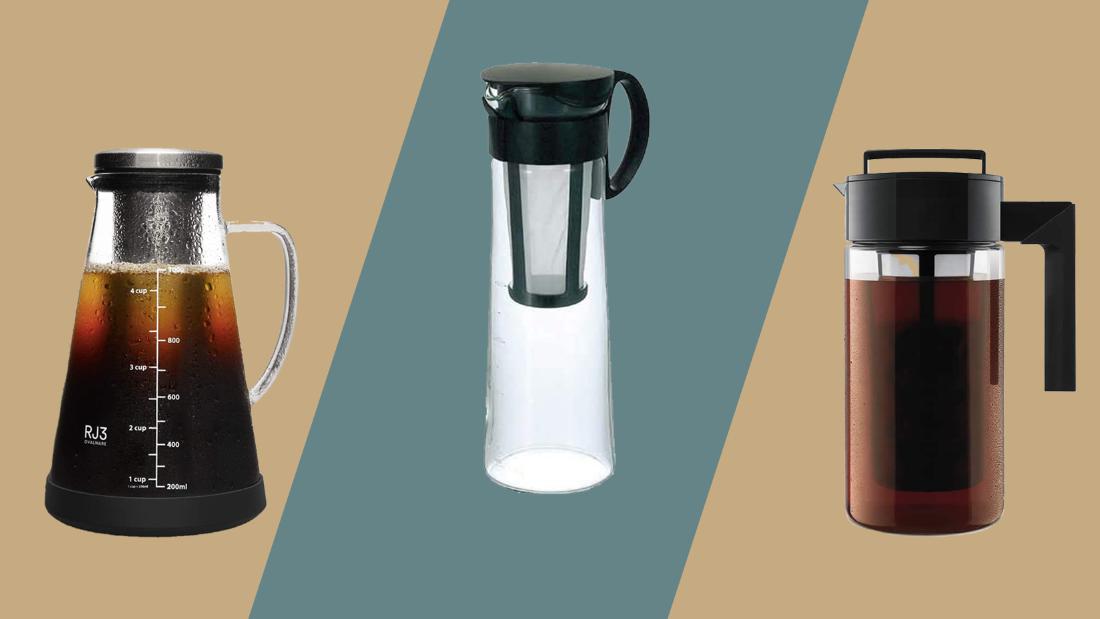(CNN) —
There’s something revitalizing about an icy glass of caffeinated brew. For many, iced coffee is the coffee of choice, regardless of season or weather. There are several ways to make a delicious iced coffee, from simply chilling leftover hot coffee or making double-strength hot and pouring it over ice, to adding freshly pulled espresso to ice or creating a fun occasion-worthy frozen coffee. But for some coffee lovers, their tried-and-true iced method is cold brew.
The sophisticated older sister of iced coffee, cold brew is an elixir that results from slowly steeping ground coffee in room temperature or cold water for a number of hours (generally eight to 24). The removal of heat from the brewing process yields a smooth, silky, less acidic liquid that goes down, we learned, quite easily. In trying to describe the difference between cold brew and regular iced coffee, one friend who tasted a couple of our batches likened it to the first time you taste higher-quality whiskey — aside from the nuances in taste, it feels softer in your mouth and smooth as it goes down.
As cold brew’s popularity has exploded, so too has the number of at-home cold brew devices. While it’s fairly easy to make top-quality cold brew at home using just a Mason jar or a French press, these cold brew-specific devices are intriguing, convenient, and — if you enjoy coffee experimentation as much as we do — a little more fun.
To bring you the best, easiest cold brew at home, we tested a range of devices using a wide set of criteria (outlined below), over several weeks. We measured, dripped, steeped, patiently waited and poured our way through a 5-pound bag of Stone Street Coffee’s cold brew reserve grind, which produced a rich, nutty, chocolaty concentrate. We tasted each brew on its own straight from the carafe, over ice and with as many different milks as we could keep in our refrigerator — and when we ran out of storage, we gave carafes to neighbors for their feedback. We drank a massive amount of cold brew, and we became converts.
Countless icy and quickly condensating glasses later, we settled on three standout brewers:
The industry experts we consulted about cold brew told us that a more expensive, complicated home device doesn’t necessarily make a better-tasting product. Ben Helfen, coffee education specialist at Counter Culture Coffee, for example, told us he makes cold brew at home in a Mason jar, then filters it through a paper filter into a second jar. After testing 11 commercial home brewers, we’re inclined to agree that in the world of cold brewing, simplicity is king.
Not by coincidence, then, the three top-scoring devices we tested were the most turnkey ones: The methodology of fill filter with grounds, add water to carafe, put lid on, and wait, appealed. There are also plenty of devices on the market that have more involved brewing processes, are more aesthetically artful, have more timing-control elements, make slightly bigger batches or have additional nifty features. We tested seven brewers that fell into this slightly more complicated category, with varying results — though not when it came to coffee taste. All seven of these, like our winning three, yielded a consistently strong, tasty, satisfying brew.
None of those additional features, though, outweighed the value of just making very good cold brew with very little work. This doesn’t mean we didn’t utilize and enjoy those additional features; we did, and we’ll outline them below.
But first, a rundown of our three highest scorers:
Overall, the Hario Mizudashi Cold Brew Coffee Pot scored highest: This sleek, sophisticated and streamlined carafe produces 1 liter (about 4¼ cups) of rich, robust brew in just eight hours. It was among the simplest to assemble, it executed an exemplary brew in about the shortest time span, and it looked snazzy doing it. Plus, it rang up as the second most affordable of our inventory.
Also pleasingly easy to use and a handsome visual addition to a breakfast table, the Ovalware Airtight RJ3 Cold Brew Maker narrowly lost to the Mizudashi only because its glass handle feels a bit more fragile and thus, slightly less user-friendly. As straightforward as any of the brewers, this was one of the most upscale design-wise, without feeling fussy.
The all-plastic Takeya Cold Brew Iced Coffee Maker turns out 1.8 liters of fantastic cold brew — a greater volume than some of its simple-carafe brethren — and is the lightest, easiest model to throw in a weekend bag without fear of breakage for on-the-go brewing for a group or larger family.
Hario Mizudashi Cold Brew Coffee Pot
The beauty of cold brew coffee shines with this device, which falls at the intersection of function, style and affordability. And the system couldn’t be easier to operate, even if one had come to it never having made a batch of cold brew.
The Mizudashi arrives in a slim, sparsely designed cardboard rectangle, and it’s a perfect harbinger of the space-conserving, efficient experience to come. There are, of course, simple-but-precise directions, with helpful graphics, but if you’re more touch-and-go with your coffee, you simply fill the filter with grounds to the top of the mesh, place the filter back into the carafe, and slowly pour filtered water over the grounds until the carafe is full (even at a slow pour, this process takes maybe 60 to 90 seconds). There’s a mark on the filter that you align with a mark on the spout of the carafe before you replace the lid to keep the filter from coming out when you remove the lid. When the lid is on, put the entire thing in the fridge and wait eight hours or so, to your preferred cold brew strength, and you’ve got 1 liter of liquid magic: roasty, chocolaty, nutty, smoky, but smoother than any coffee we’d ever tasted. All the pluses of cold brew come through in this compact delivery system.
From the unboxing of this beauty on, design lovers will appreciate the tall, slender carafe, which could be proudly displayed on any table and will fit unobtrusively on kitchen counters or within most cabinets. The filter is constructed of a light mesh and plastic. The lid and handle, made from a durable plastic that easily screws on and off during brews and cleanup, make the whole glass setup less precarious for the clumsy among us. A plastic lid secures the filter, and, once the filter is removed after steeping is done, the remaining liquid in the carafe. And cleanup is easy, thanks to the bottom of the mesh filter unscrewing for easy dumping of used grounds.
This pitcher produced consistently robust coffee and looked great (in one of three colors, black, brown and red) doing so.
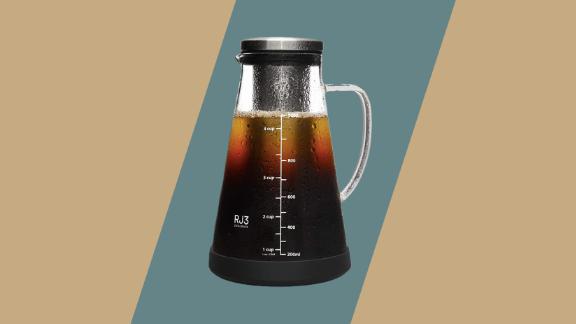
Ovalware Airtight RJ3 Cold Brew Maker
Equally aesthetically pleasing, and possibly even more user-friendly, is Ovalware’s Airtight Cold Brew Iced Coffee Maker and Tea Infuser with Spout. This device — perfect for making cold brew for one or two, as it yields 1 liter (or about 4¼ cups) of delicious, smooth coffee with a solid punch — functions using an insertable metal filter that you simply fill with grounds to the top, then slowly pour water over until you reach the “MAX” line marked clearly on the thick glass carafe. The filter is bound at the top by a rubber ring that seals it in place; the metal lid also is equipped with a rubber ring to seal the whole pitcher during brewing and storage, and a third rubber ring fits around the bottom of the glass carafe to prevent breakage and slipping during use. The glass-metal-rubber combination all feels good in your hands, if you like a tactile kitchen tool experience. This brewer reads as more luxurious than the $30 it costs.
The RJ3 is designed in a conical shape, making it feel most organically like a coffee-brewing device. The carafe is clearly marked in cup and milliliter measurements, for users who may want to brew less than the maximum.
The primary reason this one came in as runner-up is because of the carafe handle, also made of glass, which we harbored some anxiety about breaking off during the testing process. If you’re a more cautious kitchen denizen and aren’t worried about small children or household pets disturbing the handle on this one, we wholeheartedly recommend it.
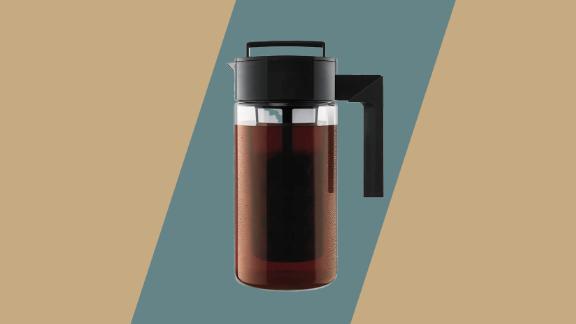
Takeya Cold Brew Iced Coffee Maker
We like to think of the Takeya Cold Brew Iced Coffee Maker as the S’well or HydroFlask of cold brewing: Fill it up, put the lid on, throw it in your bag and go anywhere with it. Well, not quite, but almost. This brewer is the height of low-tech and intuitive, and — bonus — it’s pretty portable!
The Takeya carafe and lid are made of a solid plastic, and the filter is mesh and plastic, which means the entire cold brewer is durable and pretty much unbreakable. The brew mechanism is the same as the two other winning brewers — fill filter with grounds, add water to carafe, screw on lid, sit quietly for a day — but the directions for this one specifically call for the user to shake the carafe a couple of times during brewing to mix and activate the grounds and the water. (Stirring or otherwise mixing the brew is a good idea, no matter which cold brew maker you’re using.) The lid is surprisingly secure, so there isn’t any leakage during shaking. The carafe is big and tall — it makes 1.8 liters, or 1.9 quarts, of cold brew — but the user is directed to turn it on its side in the refrigerator during steeping. During one of our test brews, a bit of coffee dribbled out, but during subsequent brews, we better secured the lid and didn’t experience any leakage. This was the most affordable brewer we tested, but it was as efficient and well-performing as any of the other brewers in our testing pool.
For a plastic brewer, the Takeya is quite nice-looking, though doesn’t provide as high-end a user experience as the glass brewers. Its minimal design makes it feel more sophisticated; however, because there are no measurement markings on the carafe, the coffee-brewing experience isn’t as precise as with the other models we tested. If you’re making less than 2 quarts, you’d have to measure out both your grounds and your water outside of this setup, but if you’re going for the maximum brew, you just add grounds and water to the top. Sort of as easy as refilling a Brita water carafe — you just stop when it looks full.
If that’s how you like to brew coffee, you want to spend less than $25, and you have a little more space in your fridge, this maker’s for you.
The testing process for these cold brewers was exhaustive, lasting more than five weeks. We evaluated each device based on criteria important to users, namely function, durability and design. We tested each device at least twice, using the same preground coffee from Stone Street. We took photos of each device’s unboxing, assembly and use, and we took notes in a spreadsheet about every detail of each of these brewers, from how they felt in our hands and how much counter space they demanded, to how they appeared during the brewing process and the liquid they produced at the end of that process. We became enamored with many of these brewers, as well as their end result: the sumptuous cold brew that became our morning’s mission over these summer weeks. We drank gallons of cold brew, and yes, lay awake at night thinking about the pros and cons of each of these devices. Read on for our evaluation criteria and their breakdowns.
Brew function
- Optimal taste: We tasted the cold brew from each device immediately after completing the recommended brew cycle, on its own, with ice, with added cold water, with different types of milks, and a day later. We rated each brewer based on the taste and perceived level of acidity of its cold brew.
- User-friendliness: We assessed how user-friendly each brewer is, both for someone who has never attempted cold brew before and for a regular cold brew consumer. We noted how easy each brewer was to assemble, how carefully each set of directions needed to be read (if at all), whether the markings on each device are easy to read and follow, and whether each device was intuitive or complicated to operate. Overall, we considered how easy it was with each device to produce a batch of cold brew, from the first opening of the brewer box through the first taste of cold brew.
- Volume yield: We noted how many ounces or liters each device can brew, and assessed how that capacity would enhance the overall user experience of that brewer — e.g., some users desire larger batches, others may be happy to produce less in one usage.
Durability
- Everyday durability/signs of damage: For this category, we observed how each brewer felt during setup, if the parts felt stable or precarious, and if any of the parts could be easily damaged during a standard brew cycle.
- Build quality: We noted what materials each brewer is made of — glass, plastic/silicon, metal — and the tangible feel of each of those materials and parts in the user’s hands.
- Serviceability: We observed the ease of opening and taking apart each of the brewers, in the case that the device would need to be serviced or parts replaced.
Set up and breakdown
- Ease of assembly: We noted how long it took to unbox each device, how many minutes it took to assemble, and whether there was any setup beyond just washing the parts with warm soapy water.
- Size: We observed how much space each device took up on the counter both during coffee setup, during the eight to 24 hours of brewing, and in the refrigerator once the cold brew is finished.
- Ease of cleanup: After each cold brew process, we noted the effort needed to clean the filter or brew basket, the carafe and any additional parts, including storage of the parts that aren’t used after the brew process is complete.
Aesthetic
- First impression: We noted our first impression of each brewer, whether it was an appealing design, and if we would want to place it on a breakfast table or look at it each morning in the refrigerator.
- Multiple color availability: We researched whether each brewer came in any colors besides the standard black.
- Warranty: We checked the number of years of warranty for each device.
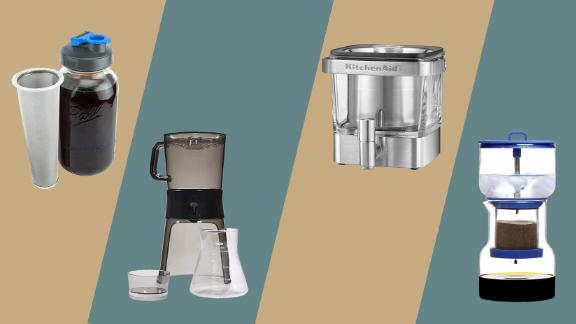
County Line Kitchen Cold Brew Coffee Maker, Oxo Good Grips Cold Brew Coffee Maker, KitchenAid Cold Brew Coffee Maker, Bruer Cold Drip System
County Line Kitchen Cold Brew Coffee Maker ($26.95; amazon.com)
From the standpoint of ease, the County Line Kitchen Cold Brew Coffee Maker was a clear standout.
Essentially a Mason jar with a screw-on lid, handle and pop-up spout, this contraption couldn’t be easier to set up, pour and clean. While the County Line Kitchen model made 1.75 liters of formidable brew with little mess or labor, it didn’t score as high in aesthetics. It’s not a high-design item, and for the more modern, discerning types among us, this may not be their, um, cup of brew. Its straightforward, rustic design also extends to the packaging and directions; when we read the brochure that comes with the County Line Kitchen model, it felt like something that might be sold in the gift store of a roadside country diner, which is an aesthetic that isn’t for everyone. For function alone, though, this one gets an honorable mention.
Oxo Good Grips Cold Brew Coffee Maker ($49.99; bedbathandbeyond.com)
The Oxo Good Grips maker brewed pretty near perfect cold brew, but the whole thing felt a bit like a chemistry experiment. You fill a big plastic tub with a whole lot of ground coffee, then you put a plastic perforated cover on it and pour the water through that cover, activating a “rainmaker” effect that supposedly evenly distributes the water over the grounds for optimal flavor extraction. There aren’t any measurement markings on the brewing container, so in theory, you use the glass carafe that eventually holds the cold brew — which resembles a chemistry beaker and does have measurements — to measure.
After letting the grounds steep in the container for 12 to 24 hours, you place the container on top of a third piece — a tower — that has a switch to release the brew, allowing it to slowly drain into the carafe. Once the coffee concentrate has drained into the carafe, you can move the plastic pieces of this tower (which nest for easy storage when not in use) aside, top the carafe with a plastic, sealable lid, and store the nice-looking carafe in the refrigerator.
During the steeping and once the coffee is brewed, this setup is fairly simple, but with all the parts laid out, it feels more cumbersome than necessary, as we thought to ourselves while unboxing this one: This isn’t an assemble-after-two-glasses-of-wine apparatus (unlike the winners).
Bonus: Oxo also makes a very cute compact version of this brewer that’s $20 cheaper and yields 16 ounces. It’s a mini-me that’s equally functional and more fitting for smaller homes/kitchens/fridges.
KitchenAid Cold Brew Coffee Maker ($99.99; bedbathandbeyond.com)
The KitchenAid model brewed excellent, very strong cold brew after 11 hours, and it offers a lot of appeal. However, its higher price tag, more cumbersome assembly, and slightly more complicated brewing process knocked it out of contention for a winning title. There are four components to assemble, so out of the box, it feels a bit more intimidating, but once we read the directions and did put it all together, this one was fairly turnkey. Fill a stainless steel steeping bucket with grounds, place it inside the brew jar, and fill the whole thing with water. The next morning, or 12 hours later, remove the steeping bucket, and voila: 28 ounces of cold brew in a solid square glass jar, with a tap for easy, spill-proof dispensing and a handle for easily moving the jar from counter to refrigerator and back again.
We did find what appeared to be a confusing error in the directions to our KitchenAid: The diagram of which way to turn the tap while steeping did not match the written directions, so we spilled some of the coffee-water while filling the brewer. Once we had this brewed and set, though, the coffee-tap function was rather pleasing, as is the handle, which turns this device into a coffee clutch of sorts. If you’re interested in those extra features, the KitchenAid is right for you.
Bruer Cold Drip System ($79.95; amazon.com or $80; bruer.co)
If it’s possible for a design to be both complicated and intuitive, the Bruer hits the mark. Everything about this feels extra, to both its benefit and detriment. The brewer arrives in a stunning cylindrical cardboard package, and the buyer gets excited, thinking they’re opening a fancy piece of glassware or some high-minded European wooden toy. There are about six different pieces to the brewer, including sleek curved glass, bright colorful silicon and brushed metal — the whole thing feels like an industrial design installation.
You add ground coffee, then slowly add a bit of water to bloom the grounds, then add remaining (ice) water and, finally, adjust the drip valve to let the water drip through the coffee at the rate of about one drip per second. So with this setup, you’re actually very slowly brewing the coffee, one drip at a time, over about six hours. Watching this brewer do its magic is mesmerizing and worthy of a time-lapse video — this is perhaps the Technivorm MoccaMaster of cold brewers — and for that reason, plenty of users will love it. It does make an excellent cup of cold brew, but not everyone will want this much processing just to get a cup of coffee. Gosh, it’s fun to observe, though, if you have the patience and need a new hobby.
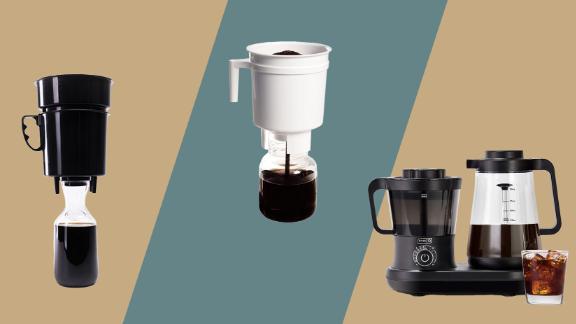
Filtron Cold Water Coffee Concentrate Brewer, Toddy Cold Brew System, Dash Cold Brew Coffee Maker
Filtron Cold Water Coffee Concentrate Brewer ($39.95; filtron.com)
The Filtron is an old-school kind of setup: a big bucket that you fill with grounds and then put a literal plug in the bottom, a water bowl on top and a plastic guard in between. The water slowly drips into the coffee bowl, and the brew slowly steeps. Steeping takes 12 to 24 hours, then you place the bowl on top of the carafe (which resembles a wine carafe in an old Little Italy red-checkered-tablecloth restaurant), unplug and watch the coffee drip through. The result is 1.5 liters of cold brew, which is a nice amount for a bigger group or family.
Setup of the Filtron, though — washing all the components, soaking the filter pad, measuring out the coffee and water — took about 20 to 25 minutes, which, compared with the other devices we tested, just felt like a lot. Also, there’s no top to cover the water bowl during steeping; one could and probably should cover the bowl with plastic wrap, but the fact that there isn’t a built-in part to cover it felt like a design omission. Still, the carafe is cute, and easy to store in the refrigerator. In the end, the resulting coffee was fine, but not among the best brews we tasted, and this all felt like more effort than we wanted to invest.
Toddy Cold Brew System ($34.95; amazon.com)
The Toddy operates similarly to the Filtron: Fill a big plastic bucket with grounds, plug up the bucket at bottom, fill the bucket with water, let steep, release coffee into carafe 12 to 24 hours later. The Toddy process is appealing in a way, like a giant chemistry set, but like the Filtron, it’s a lot of parts and labor for an outcome similar to what you’d get with less complicated devices.
The brew bucket balances on a skinny foundation, and during testing, we were anxious that it might tip over and spill its 1.65 liters of dark syrup all over the counter and floor (it did not). It also takes up a lot of counter space, and the bucket, which is white, is a bit laborious to clean since the grounds’ oils stick to it and are visible on the white plastic. The whole thing is a little involved, we thought, but if you like your Coffee Making, with a capital C and capital M, to feel like a mad scientist’s lab, this is a fun option to try.
Dash Cold Brew Coffee Maker ($89.80, originally $129.99; amazon.com)
The Dash Cold Brew Coffee Maker was different from any other device we tested; it’s the only machine that makes cold brew fast, in five to 15 minutes, depending on how much time you have. That’s a fun feature, if somewhat unorthodox in the cold brew universe. There are multiple parts to this machine (and yes, it plugs into an outlet and uses electricity), and the first time we tested it, we didn’t secure the filter properly and coffee liquid began spewing all over the countertop — our bad, sure, but you do have to pay attention when putting this together for the first time.
It operates in a way like a stovetop percolator, in that you pour water into one section, and it percolates quickly, through grounds, to another section, resulting in coffee liquid. This process, which makes a slightly distracting whirring sound for those five to 15 minutes, ultimately makes a delicious cold brew — and one that doesn’t take a whole night to make — but it does take some patience to assemble and get working. If you want cold brew, you want it now, and you’re not a purist when it comes to process, this is an appealing option. It is, however, difficult to get all the liquid coffee out of the maker if you are, say packing it up to move or storing it for the winter. Bottom line: You’ll get cold brew in a few minutes, if that’s your wish.
Read more from CNN Underscored’s hands-on testing:
